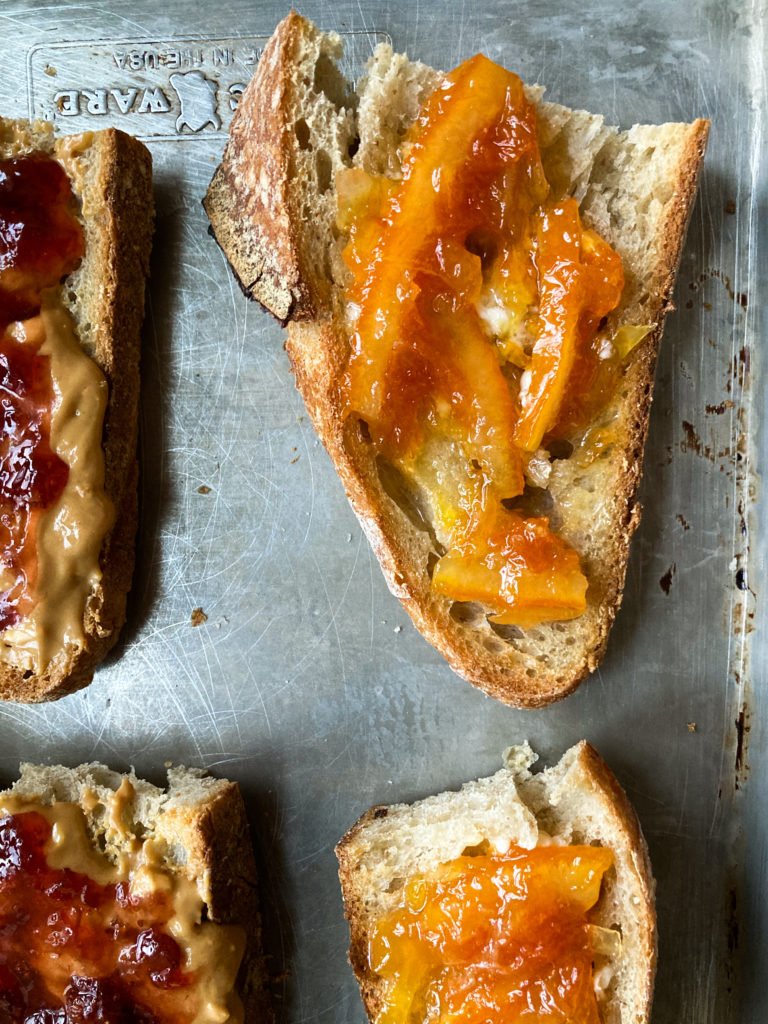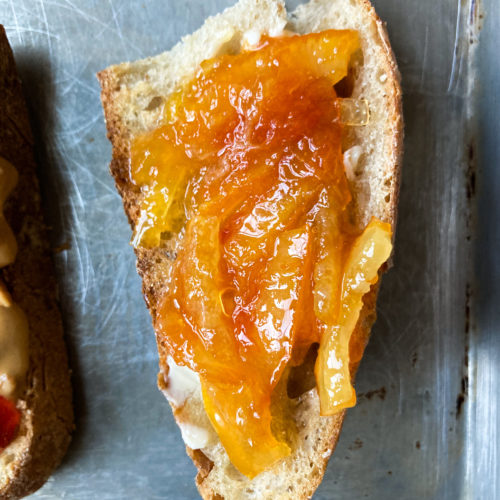I remember the days when I was in grad school, heartily procrastinating doing my experiments / coordinating confectionery science classes / going to class by bopping through all of my favorite cooking blogs. Smitten Kitchen, Oh She Glows, Minimalist Baker, Joy the Baker, Oh Lady Cakes…ahh, those were the days. I am honestly not sure how I got all my shit done in grad school, but by the confectionery goddesses, I did it. It’s a fond memory. And speaking of memories, I remember that my mom would typically have a jar of Smuckers (?) orange marmalade in the fridge growing up, usually in the door where the strawberry jam (from my grandma) and elderberry syrup (also from my grandma) would live on permanent rotation.
Orange marmalade for me, is a winter preserve, since citrus season for us norther hemisphere-dwellers is during our winter season. This works for me, since early summer is strawberry season, and therefore strawberry jam season. So, needless to say, I think my rotation for jams here on out will be strawberry jam in summer, and orange marmalade in winter. I can live with that.
In the past, I’ve made orange marmalade by carefully slicing off the oily citrus skins, and finely slicing them. Then, I’d supreme the citrus (oranges, grapefruit, lemon, blood orange….), and get on with the cooking part. That was tedious, so I tried this current method this year – slicing the whole fruit as thinly as patience will tolerate.
For me, my patience was moderate – distracted by the many house-related projects/things to do, etc. that go with moving into your first home – which resulted in a fairly textured jam. Next year, I will be sure to try to marmalade on a day in which my patience is higher in order to get thinner slices – but honestly, the chunky result wasn’t bad at all. Just a preference thing. Also, next year, we won’t be buying a house, so there is that factor as well.

I used cara cara oranges, and 1 whole lemon. I’ve used blood orange in the past, as well as grapefruit. Really, any citrus will work – as long as you like eating it out of hand, you will like it in marmalade. The addition of lemon is key for using sweet citrus, but if using a more tart or bitter citrus, you can consider omitting. Just hit the gram weights specified in the recipe, slice your citrus thinly with your sharpest knife at peak patience, and boil the jam to the temperature specified in the recipe – and you’ll be good to go!
If you don’t have a kitchen scale, then go and purchase one. It’ll be well worth the $15 investment down the line, I promise. This marmalade can be packed in pints or half-pints, with processing time of 5 minutes being the same for both. As always, only consult reputable sources when canning or preserving, like the National Center for Home Food Preservation. My recipe is an adaptation of Alton Brown’s and Liz Pruitt’s.

Orange Marmalade
Ingredients
- 1000g oranges washed, sliced in ⅛” slices then quartered
- Peel of 1 large lemon peeled in strips & sliced into thin ⅛” slices
- Juice of the lemon
- 750g water
- 750g sugar
Instructions
- Prepare a small saucepan with lids for jars. Get lid rings out and ensure you have one for each lid. Bring lids to a simmer, and then turn down heat but keep warm. Sterilize jars, ladle and jam stirring spatula in the dishwasher or boil in hot water for 15 minutes. Use the same large pot that you will process the jam in. Remove jars, ladle and spatula, and set on a clean towel near where you will be cooking the jam. If you have sterilized jars and tools in dishwater, prepare a hot water bath in a large stock pot or canning pot. I fill ½ full, then fill to the necessary fill line after jam jars are added in step 8.
- To a large heavy bottomed pan, add sliced oranges, sliced lemon peel and lemon juice. Add 750g water. Bring to a boil, cover pan slightly, turn down heat to a strong simmer and cook for 40 minutes. The oranges will be tender.
- To the orange-water-lemon mixture, add the sugar.
- Put a plate in the freezer.
- Bring the jam to a good simmer over medium-high heat. Cook jam until it thickens and darkens slightly in color. Stir occasionally, to prevent scorching. It will take about 15-25 minutes for the jam to reach 221-222F, but it must be cooked to this temp for texture, so have patience.
- You can test your jam texture as it cooks by putting a small blob on the cold plate, but this is purely optional if you cook to temperature. I still do it, for fun!
- Once temperature is reached, off the heat and set the pan on a heat-proof surface or trivet. Ladle the jam into the sterile jars to just below where the threads begin (the jam will expand a bit during processing). Wipe down the jar of any jam that spilled onto the rim. Place a warm lid on each jar, followed by a band. Tighten bands hand-tight.
- Process the jam: place a kitchen towel or a canning trivet into the hot water bath from step 1. Add jam filled jars. Add water to cover the jam fill line in jars by 1”. Bring to a full boil. Boil pints and half pints for 10 full minutes. Remove jars of jam to a clean towel, and allow to cool completely and set – 24 to 48 hours. Test for seal (push down on lid, should have been sucked into the jar; if not, re-process in boiling water for 10 minutes or store jam in the fridge and consume within a few months). For properly processed jam, store in a dark, cool place for up to 1 year. Refrigerate after opening.

